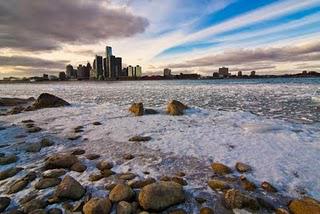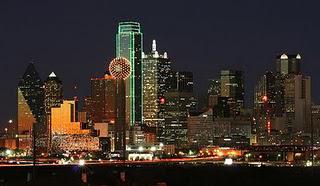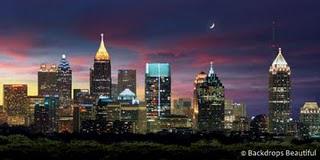To read the first two parts of this climate series, use these links:
The Perfect Climate - Part 1
The Perfect Climate - Part 2
"...[Detroit's] winters are cruel - January temperatures average 24.7 degrees - and Americans do seem to love warm weather. Over the last century, no variable has been a better predictor of urban growth than temperate winters." - Edward Glaeser, The Triumph of the City

The cold is one reason people continue to flee Detroit
This excerpt from Glaeser's wonderful new book supports the argument that I have been making in my climate rankings. That is, that the warmer the weather, and especially the warmer the winter, the better.In Part 1, I presented my climate formula and the ranking of all U.S. metropolitan areas. In Part 2, I provided some commentary on these rankings. I received many comments from readers in support of cold locations that ranked low on my rankings. I even received vehement arguments from residents of Barrow, Alaska and Leadville, Colorado extolling the virtues of these very cold climates. Of course these perspectives are totally valid, but my argument remains that most people prefer warm to cold. My intuition told me that U.S. demographic trends substantiated this assertion, and the expert analysis of Glaeser supports it even further. Still, it's worth testing my intuition and Glaeser's statement with facts.
Here is a list of the ten metropolitan areas that have see the largest net increase in population since 1950 along with their climate score and associated rank among the 30 largest metropolitan areas:
[Note the population changes are approximate because the Census Bureau has changed the definition for metropolitan areas multiple times since 1950.]
(population change in thousands of people / climate score / rank out of top 30 metro areas)
1. Los Angeles, CA - 8,530 / 37.1 / 3
2. New York, NY - 6,190 / 4.3 / 20
3. Dallas, TX - 5,790 / 18.0 / 12
4. Houston, TX - 5,090 / 29.5 / 6
5. Miami, FL - 5,000 / 44.9 / 1
6. Atlanta, GA - 4,830 / 16.6 / 13
7.Chicago, IL - 4,100 / 1.3 / 25
8. Phoenix, AZ - 4,070 / 21.0 / 11
9. Washington, D.C. - 4,040 / 9.0 / 18
10. Riverside, CA - 3,800 / 21.3 / 8

People continue to move to "warm" Dallas and other Texas cities
Seven of the ten cities on this list can be described as "warm" with mild winters. The only three on the list that have cold winters are New York, Chicago, and Washington, D.C. (and Washington occasionally experiences mild winters). It makes sense that New York and Chicago would be on this list because of their size and economic importance. Washington ranks because of the massive growth of the federal government since World War II.But consider the other seven cities on this list. Only Los Angeles ranked among the ten largest metropolitan areas in 1950. Now five of these cities do with Phoenix and Riverside ranked 12th and 14th, respectively. If current trends continue, these two cities will probably rank 10th and 11th within this decade.
Surely there are more than just climate factors driving the growth of these cities. Dallas, Houston, and Atlanta all have the reputation as business-friendly, job-rich regions. But the correlation of warm temperatures to population growth is compelling.
It really is remarkable that the city of Phoenix had barely more than 100,000 people in 1950, and now has grown to a city of nearly 1.5 million people, the sixth largest in the country. And Phoenix could not be a better demonstration of the American preference for a mild winter as opposed to a mild summer. The mean December to February temperature in Phoenix is a comfortable 57 degrees. The mean June to August temperature is a stifling 92 degrees. The residents of the Valley of the Sun are clearly more willing to endure a long hard summer for the relief of an easy winter.
From the mid-twentieth century on, the ubiquity of air-conditioning, the construction of the massive interstate and national highway system, and cheap air travel, have allowed Americans to migrate from the cold cities of the north and east. Add to that the decline of manufacturing (as a percentage of jobs anyway), and other shifting economic patterns, and we have and continue to witness an American demographic revolution toward the heat and sun.
---
Consider the list of all major metropolitan areas (more than 1 million people) that grew by 10% or more between 2000 and 2009, most are in "warm" climates (climate scores higher than 10), including the top 15:
(population growth % 2000-2009 / climate score)
1. Raleigh, NC - 41.3% / 13.5
2. Las Vegas, NV - 38.3% / 13.0
3. Austin, TX - 36.4% / 23.0
4. Phoenix, AZ - 34.2% / 21.0
5. Charlotte, NC - 31.2% / 14.4
6. Atlanta, GA - 28.9% / 16.6
7. Riverside, CA - 27.3% / 25.3
8. Orlando, FL - 26.6% / 36.4
9. Dallas, TX - 24.9% / 18.0
10. Houston, TX - 24.4% / 29.5

Atlanta, just warm enough to take the edge off winter
11. San Antonio, TX - 21.1% / 23.9
12. Tucson, AZ - 20.9% / 22.0
13. Nashville, TN - 20.6% / 11.0
14. Sacramento, CA - 18.4% / 22.4
15. Jacksonville, FL - 18.3% / 30.6
16. Denver,CO - 17.1% / -0.4
17. Salt Lake City, UT - 16.7% / 4.1
18. Portland, OR - 16.3% / 13.9
19. Tampa, FL - 14.7% / 37.8
20. Indianapolis, IN - 14.3% / 1.9
21. Washington, D.C. - 14.2% / 9.0
22. Richmond, VA - 12.9% / 9.6
23. Kansas City, MO - 12.6% / 3.3
24. Seattle, WA - 12.0% / 14.2
25. Oklahoma City. OK - 12.0% / 6.8
26. Columbus, OH - 11.7% / 1.9
27. Miami, FL - 10.8% / 44.9
28. Minneapolis, MN - 10.1% / -12.6

